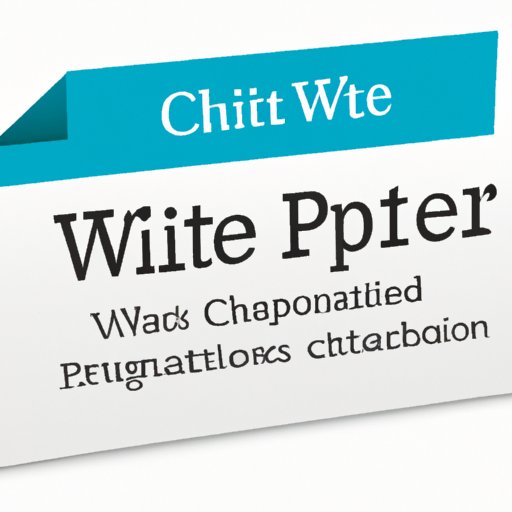
I. Introduction
Citing sources in research is of utmost importance in establishing credibility and authority in academic writing, and avoiding plagiarism. Proper citation gives credit to those whose work and ideas the researcher draws upon, supporting a larger knowledge base of the field. However, citing websites with no authors can be a challenge for researchers, as it is common for online material to lack attribution. This article will provide the readers with APA guidelines and alternative methods on how to cite a website with no author.
II. The Challenge of Citing a Website with No Author
Among the diverse types of online sources, citing a website with no author has become one of the most common. This is because many websites are created by organizations rather than individual authors. However, this attribution deficit creates significant challenges for researchers when trying to acknowledge the sources used in their research. Researchers who fail to cite these sources correctly risk creating confusion, undermining the credibility and quality of their work.
III. APA Guidelines for Citing a Website with No Author
APA style is an essential guide for researchers who are writing in the social and behavioral sciences. The guidelines provide a format for in-text citations and reference list entries that allows readers to identify the sources used in research easily. The guidelines provide the following format for in-text citations:
(“Title of Webpage,” Year)
If the title of the webpage is long or complex, it may be abbreviated. Researchers can then include the full title as it appears in the reference list section of the paper. Additionally, the reference entry should begin with the title of the webpage, followed by the publishing date, and the URL.
For example:
In-text citation: (“40-year-old photos show how much Disney World has changed,” 2021)
Reference List entry: 40-year-old photos show how much Disney World has changed. (2021, May 21). Retrieved from https://www.msn.com/en-us/travel/travel-photography/40-year-old-photos-show-how-much-disney-world-has-changed/ss-AAKHnaP
IV. Alternative Methods for Identifying Authorship
In some cases, identifying the author is not possible. Therefore, researchers may have to use the title, group author, or publisher in place of the individual author’s name in citations.
A title can be used if no author is identified. In such cases, researchers are instructed to use the first few words of the title inside quotation marks or italicized. Once the title is complete, it is followed by the date of publication.
For example:
In-text citation: (“Why Dogs Make Great Pets,” 2019)
Reference List entry: Why Dogs Make Great Pets. (2019). Retrieved from https://www.yourpets.com/pets/dogs/make-great-pets/
Another possibility is to use a group author to stand in for the absent individual author’s name. This can be appropriate when the group that produced the material bears responsibility for its content.
For example:
In-text citation: (National Institute of Mental Health, 2017)
Reference List entry: National Institute of Mental Health. (2017). Depression. Retrieved from https://www.nimh.nih.gov/health/topics/depression/index.shtml
V. The Issue of Electronic Source Reliability and Credibility Evaluation
Before citing a website source, researchers must evaluate the reliability and accuracy of the site’s information. The abundance of information on the internet makes it essential to exercise critical judgment and assess the information’s credibility.
Researchers should evaluate the author’s expertise, the site’s purpose, and the sources used to support its claims. Additionally, researchers may use critical evaluation tools such as the author’s credentials, the author’s affiliation, the date of publication, and references when available. Proper evaluation maximizes the credibility and reliability of information sources, which ultimately strengthens the researcher’s work.
VI. Summary and Conclusion
Proper citation is imperative to enhance credibility and authority in academic writing and avoiding plagiarism. Citing websites with no authors can be a struggle, but with APA guidelines, it can become achievable with proper sources. Alternative methods could also be used if the author is not identified. Electronic source reliability and credibility evaluation is also critical in referencing sources. The critical assessment of online resources is a necessary step in the research process. Through careful evaluation, researchers can ensure that their works are of the highest possible quality, achieving their intended purpose.
To avoid common errors when citing websites with no authors in APA format, students and researchers should become familiar with the guidelines and utilize critical judgment in determining their sources’ reliability and accuracy.




